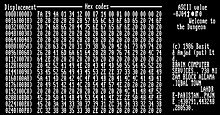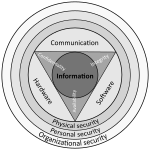Computer virus
[8] Motives for creating viruses can include seeking profit (e.g., with ransomware), desire to send a political message, personal amusement, to demonstrate that a vulnerability exists in software, for sabotage and denial of service, or simply because they wish to explore cybersecurity issues, artificial life and evolutionary algorithms.[10] In response, an industry of antivirus software has cropped up, selling or freely distributing virus protection to users of various operating systems.[13] In 1972, Veith Risak directly building on von Neumann's work on self-replication, published his article "Selbstreproduzierende Automaten mit minimaler Informationsübertragung" (Self-reproducing automata with minimal information exchange).[14] The article describes a fully functional virus written in assembler programming language for a SIEMENS 4004/35 computer system.In 1980, Jürgen Kraus wrote his Diplom thesis "Selbstreproduktion bei Programmen" (Self-reproduction of programs) at the University of Dortmund.[21] Written in 1981 by Richard Skrenta, a ninth grader at Mount Lebanon High School near Pittsburgh, it attached itself to the Apple DOS 3.3 operating system and spread via floppy disk.[22] It was the first paper to explicitly call a self-reproducing program a "virus", a term introduced by Cohen's mentor Leonard Adleman.The next time a user tries to start the desktop, the virus will immediately load and run as part of the master boot record.This approach does not fool antivirus software, however, especially those which maintain and date cyclic redundancy checks on file changes.[56] In the 2010s, as computers and operating systems grow larger and more complex, old hiding techniques need to be updated or replaced.[57] While some kinds of antivirus software employ various techniques to counter stealth mechanisms, once the infection occurs any recourse to "clean" the system is unreliable.The interception can occur by code injection of the actual operating system files that would handle the read request.[citation needed] A simpler older approach did not use a key, where the encryption consisted only of operations with no parameters, like incrementing and decrementing, bitwise rotation, arithmetic negation, and logical NOT.A well-written polymorphic virus therefore has no parts which remain identical between infections, making it very difficult to detect directly using "signatures".[69][70] Damage is due to causing system failure, corrupting data, wasting computer resources, increasing maintenance costs or stealing personal information.[73] Stability test applications are similar programs which have the same effect as power viruses (high CPU usage) but stay under the user's control.For this reason, many viruses attach themselves to executable files that may be part of legitimate programs (see code injection).In a 2015 experiment, researchers at the University of Michigan found that 45–98 percent of users would plug in a flash drive of unknown origin.[79][80][81][82] While Linux and Unix in general have always natively prevented normal users from making changes to the operating system environment without permission, Windows users are generally not prevented from making these changes, meaning that viruses can easily gain control of the entire system on Windows hosts.This difference has continued partly due to the widespread use of administrator accounts in contemporary versions like Windows XP.Until floppy disks fell out of use, this was the most successful infection strategy and boot sector viruses were the most common in the "wild" for many years.[93] There have been multiple instances of the cross-site scripting viruses in the "wild", exploiting websites such as MySpace (with the Samy worm) and Yahoo!."[95][96][97] Many users install antivirus software that can detect and eliminate known viruses when the computer attempts to download or run the executable file (which may be distributed as an email attachment, or on USB flash drives, for example).Ransomware and phishing scam alerts appear as press releases on the Internet Crime Complaint Center noticeboard.Some websites—like Google subsidiary VirusTotal.com—allow users to upload one or more suspicious files to be scanned and checked by one or more antivirus programs in one operation.Many such viruses can be removed by rebooting the computer, entering Windows "safe mode" with networking, and then using system tools or Microsoft Safety Scanner.[123] The 1973 Michael Crichton sci-fi film Westworld made an early mention of the concept of a computer virus, being a central plot theme that causes androids to run amok.[124][better source needed] Alan Oppenheimer's character summarizes the problem by stating that "...there's a clear pattern here which suggests an analogy to an infectious disease process, spreading from one...area to the next."Malware Museum of Art is hosted at The Internet Archive and is curated by Mikko Hyppönen from Helsinki, Finland.), corrupting data, displaying political, humorous or threatening messages on the user's screen, spamming their e-mail contacts, logging their keystrokes, or even rendering the computer useless.



Hex dumpmalwarecomputer programsinsertingviruseshost programcomputer wormsocial engineeringdeceptionssecurity vulnerabilitiesantivirus softwareprofitransomwaresabotagedenial of servicecybersecurityartificial lifeevolutionary algorithmsoperating systemsHistory of antivirus softwareHistory of ransomwareHistory of malwareTimeline of computer viruses and wormsMalware researchJohn von NeumannUniversity of IllinoisAutomataself-replicationassemblerDiplomUniversity of DortmundMacMagCreeper virusARPANETInternetBBN TechnologiesPDP-10Elk ClonerRichard SkrentaMount Lebanon High SchoolPittsburghApple DOSfloppy diskFred CohenUniversity of Southern CaliforniaLeonard Adlemanalgorithmcompression virusantivirusWindowsJ. B. GunnIBM PC compatibleboot sector(c)BrainLahore, PakistanMicrosoft WindowsWindows 3.0Windows APIDOS interruptsBizatchWindows 95Windows NThome computersSCA virussearch routineJerusalem DOS viruslogic bombpayloadvirus hoaxlife cyclebiologybinary executables.COM filesMicrosoft WordPDF fileshard driveinterrupt handlingfunctionscontrol flowMicrosoft Outlookmacro languageattachmentse-mailsMaster Boot Recordhard disk drivesolid-state driveflash drivesfloppy disksemail attachmentsdeceptionsoftwarecyclic redundancy checksCIH virusPortable ExecutablerootkitprocessesNTFS file systemcode injectionheuristicshashescryptographic hash functionsSystem File CheckerSelf-modifying codeencryptioncryptographic keycleartextXORingrebootedcryptovirologyPolymorphic codethreatdecryptionemulatorpolymorphic enginemutationmetamorphic codeW32/Simileassembly languageCPU power dissipationthermal energycentral processing unitsthermal design powerintegration testingbenchmarkingStability testoverclocking